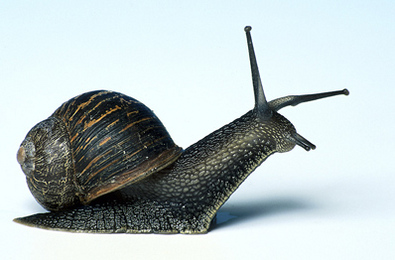
SLUGS…..YUCK!!!
Who is chewing all those ragged holes in the leaves of your beautiful plants? It could very well be slugs or snails.
Garden slugs like to hide in dark, moist places during the day, and at night they crawl out of their hidey holes to munch on your plants or ripening vegetables. The evidence these night stalkers leave behind will tell you slugs are the culprits. They leave plants pockmarked with irregularly shaped holes and a silvery slime trail to show where they’ve been.
Slugs will eat holes in ripening tomatoes and crawl right inside the fruit, giving you a nasty surprise when the tomato is harvested.
Slugs get a bad reputation but they do have some redeeming qualities. They are actually beneficial creatures who recycle organic matter and help build soil. Think of slugs as tiny composters. Garden snails perform the same service; they’re just slugs who carry their home around with them. Slugs and snails are also a food source for other wildlife such as birds, snakes, toads, small mammals and even fireflies.
But when slugs cause damage to our plants or ripening vegetables, it’s time for them to go. There are a variety of products available that claim to eliminate slugs, but you don’t need to spend a lot of money to rid your garden of slugs.
Slugs thrive in moist, shady conditions. They like to hide under debris, under plants that offer the deep shade they love, and under logs or rock piles. To help prevent slug damage, water your garden in the morning so the plants are dry by evening when slugs are active.
You can use their attraction to shade to trap slugs. Set out boards, shingles or damp newspaper in the garden overnight. The slugs will see this as a new place to hide. In the morning lift the boards or newspaper, collect the slugs that have gathered beneath it and drop them into a container of soapy water.
Do this for several nights and the slug population will be significantly reduced.
Another simple way to eliminate slugs is to use ordinary household ammonia. Add 2 ½ cups of ammonia to a gallon jug, then fill the jug with water. Spray this solution at dusk when the slugs are
active.
Be especially careful to spray under the leaves and on the ground beneath the plants where slugs hang out. If you’re using boards or wet newspapers to catch slugs you can also spray
this solution on the slugs that have gathered overnight. The spray will kill slugs on contact, and since ammonia is a source of nitrogen, the spray will also give your plants a little boost.
When spraying the ammonia solution, be careful to not get it in your eyes.
How does one kill a plant called Devil’s Shoelace/Shoestring?
Michael,
Cut it back to the ground then spray any new growth as soon as it appears and keep repeating the process. Or cut back and cover the area with two layers of cardboard then 4″ of mulch.
Just put the slugs in the garden of your enemies. No murder needed.
The neighbor will grow a crop of weeds to repay you. Instant Karma will be your reward!
You’re a slug murderer.
We moved to Greensboro, NC since 11/2010. We had a house built. I don’t know a thing about landscaping. The ground is mainly clay, acidic. zone 5-9? I have a lot of different weeds. My roses, and other plants have been damaged, The company charge too much monthly. How can I battle these tiny “things” that are eating my plants?
Nydia,
If you want to spray for insects etc. you can use products like neem oil, insecticidal soap or go to the garden store and get a general insecticide. If you search this site for “weed control” you’ll find some helpful information.